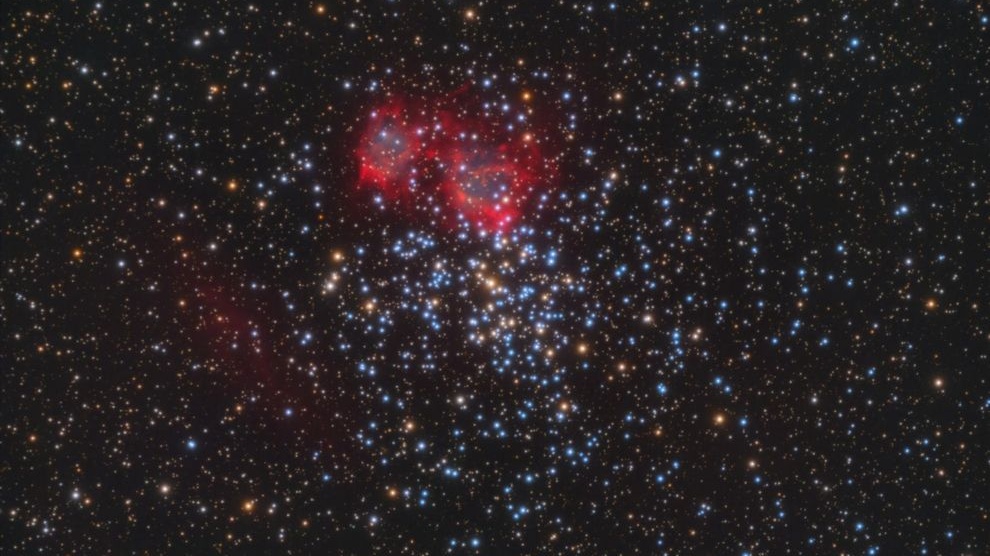Dead star at heart of cosmic graveyard predicts the sun's fate
Researchers investigated the planetary nebula in Messier 37 as though it were a cosmic crime scene to determine how its central white dwarf star died.

For the first time, astronomers have studied a dead star sitting in the heart of a cosmic graveyard of similarly aged stellar bodies.
The stellar remnant, a white dwarf, lies at the center of a cloud of stellar wreckage, gas and dust that astronomers call a planetary nebula. It's located in the open star cluster Messier 37, which is around 4,500 light years from Earth. Not only could studying this white dwarf and its surroundings reveal how it died, almost like examining a cosmic crime scene, but it could also give astronomers a glimpse at what our own solar system will look like in around 5 billion years.
That is because, when the sun runs out of fuel for its intrinsic nuclear fusion processes, it will swell into a red giant. Its puffed-up outer layers will then swallow the inner planets, including Earth. Then, as its shell of stellar material spreads out and cools, the sun will become a planetary nebula — which confusingly has nothing to do with planets — and its core will turn into a fading white dwarf.
The butterfly-shaped Messier 37 is an open cluster of stars; the stars within are thought to have been born from the same vast, dense cloud of gas and dust at around the same time. That means, by studying a dead star in this cluster, scientists can get a better picture of how stars of the same age (but with various masses) evolve and die.
In this way, open clusters serve as the perfect cosmic lab to test theories of stellar evolution.
Related: Gaia telescope’s new data reveals ‘goldmine’ of over 500,000 undiscovered stars and more
Massive stars live fast and die young
Thus far, astronomers have only discovered three open star clusters containing planetary nebulas, and the white dwarf stars buried at the hearts of these stellar graveyards have never been studied. Before now, that is.
Breaking space news, the latest updates on rocket launches, skywatching events and more!
"The stars in a cluster are all the same age; that has a special significance for astrophysics," Klaus Werner, study team leader and a professor at the University of Tübingen, said in a statement. "The more massive a star is, the faster it consumes its nuclear fuel by fusing hydrogen into helium. So its life is shorter and it evolves into a white dwarf faster."
Part of the stellar process that isn’t yet fully understood is the rate at which stars lose mass before hitting their white dwarf phases, with the relationship between a star's birth mass and death mass called the "initial-final mass relation." In other words, the mass of a white dwarf can be directly connected to the mass of the star that died to create it. Stars like our sun lose just under half their mass by the time they have evolved into white dwarfs. Stars with eight times the mass of the sun lose about 80 percent of their mass," Werner explained. "The data from very young white dwarfs are particularly valuable, as these are the central stars of planetary nebulas."
Werner added that none of the dead central stars of planetary nebulas have been studied before because they are all very distant and, as white dwarfs, are also very faint. The team rectified this by training one of the planet’s largest telescopes — the Gran Telescopio Canarias on the island of La Palma in the Canary Islands — on the cosmic graveyard in Messier 37.
They then assessed the white dwarf's light output and determined that it currently has around 85% of the mass of the sun. This indicates the star that died to leave behind this stellar remnant had a mass equivalent to 2.8 times that of the sun. It also means, according to Werner, that the star lost 70% of its matter during its lifetime.
Additionally, the team was able to determine the chemical composition of the white dwarf in Messier 37, finding it to strangely lack hydrogen on its surface. This indicates it was involved in some form of violent event in its past, such as a brief burst of nuclear fusion — something white dwarfs may undergo when stripping material from a binary companion and pulling it closer.
A better understanding of the initial-final mass relation is vital to decoding how long a star will live, and whether its final phase will be a white dwarf, a neutron star — or possibly, a black hole. The relationship can also help determine if a star in its death throes will trigger a supernova, thereby spreading all of the material it has forged during its lifetime out into the universe. That material would then become the building blocks for the next generation of stars.
"New generations of stars are formed from the ejected matter, enriched in heavy elements as products of nuclear reactions," Werner concluded. "This is what the chemical evolution of galaxies — and ultimately the entire universe — depends upon."
The team’s research was published on Oct. 11 in the journal Astronomy & Astrophysics.

Robert Lea is a science journalist in the U.K. whose articles have been published in Physics World, New Scientist, Astronomy Magazine, All About Space, Newsweek and ZME Science. He also writes about science communication for Elsevier and the European Journal of Physics. Rob holds a bachelor of science degree in physics and astronomy from the U.K.’s Open University. Follow him on Twitter @sciencef1rst.

